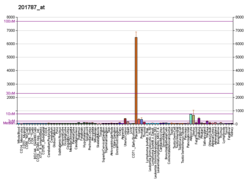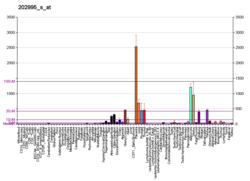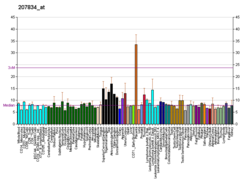Protein-coding gene in the species Homo sapiens
| FBLN1 |
|---|
|
| Identifiers |
|---|
| Aliases | FBLN1, FBLN, FIBL1, fibulin 1 |
|---|
| External IDs | OMIM: 135820; MGI: 95487; HomoloGene: 21295; GeneCards: FBLN1; OMA:FBLN1 - orthologs |
|---|
| Gene location (Human) |
|---|
 | | Chr. | Chromosome 22 (human)[1] |
|---|
| | Band | 22q13.31 | Start | 45,502,238 bp[1] |
|---|
| End | 45,601,135 bp[1] |
|---|
|
| Gene location (Mouse) |
|---|
 | | Chr. | Chromosome 15 (mouse)[2] |
|---|
| | Band | 15|15 E2 | Start | 85,090,150 bp[2] |
|---|
| End | 85,170,736 bp[2] |
|---|
|
| RNA expression pattern |
|---|
| Bgee | | Human | Mouse (ortholog) |
|---|
| Top expressed in | - canal of the cervix
- gallbladder
- vena cava
- pericardium
- gastric mucosa
- ectocervix
- vagina
- left uterine tube
- right auricle
- tendon of biceps brachii
|
| | Top expressed in | - aortic valve
- otic vesicle
- ascending aorta
- otic placode
- ciliary body
- external carotid artery
- saccule
- mandibular prominence
- internal carotid artery
- maxillary prominence
|
| | More reference expression data |
|
|---|
| BioGPS | 

 | | More reference expression data |
|
|---|
|
| Gene ontology |
|---|
| Molecular function | - fibronectin binding
- calcium ion binding
- extracellular matrix structural constituent
- fibrinogen binding
- integrin binding
- protein C-terminus binding
- protein binding
- identical protein binding
- peptidase activator activity
- protein-containing complex binding
| | Cellular component | - elastic fiber
- extracellular matrix
- fibrinogen complex
- basement membrane
- extracellular exosome
- extracellular space
- extracellular region
- collagen-containing extracellular matrix
| | Biological process | - negative regulation of protein phosphorylation
- negative regulation of cell adhesion
- negative regulation of stem cell proliferation
- positive regulation of fibroblast proliferation
- positive regulation of substrate-dependent cell migration, cell attachment to substrate
- negative regulation of cell motility
- negative regulation of transformation of host cell by virus
- positive regulation of peptidase activity
- positive regulation of gene expression
- negative regulation of ERK1 and ERK2 cascade
- integrin-mediated signaling pathway
- blood coagulation, fibrin clot formation
- negative regulation of substrate adhesion-dependent cell spreading
- viral process
- embryo implantation
- extracellular matrix organization
| | Sources:Amigo / QuickGO |
|
| Orthologs |
|---|
| Species | Human | Mouse |
|---|
| Entrez | | |
|---|
| Ensembl | | |
|---|
| UniProt | | |
|---|
| RefSeq (mRNA) | |
|---|
NM_006487
NM_001996
NM_006485
NM_006486 |
| |
|---|
| RefSeq (protein) | |
|---|
NP_001987
NP_006476
NP_006477
NP_006478 |
| |
|---|
| Location (UCSC) | Chr 22: 45.5 – 45.6 Mb | Chr 15: 85.09 – 85.17 Mb |
|---|
| PubMed search | [3] | [4] |
|---|
|
| Wikidata |
| View/Edit Human | View/Edit Mouse |
|
FBLN1 is the gene encoding fibulin-1, an extracellular matrix and plasma protein.[5][6][7]
Function
Fibulin-1 is a secreted glycoprotein that is found in association with extracellular matrix structures including fibronectin-containing fibers, elastin-containing fibers and basement membranes. Fibulin-1 binds to a number of extracellular matrix constituents including fibronectin,[7] nidogen-1, and the proteoglycan, versican.[7][8] Fibulin-1 is also a blood protein capable of binding to fibrinogen.[9]
Structure
Fibulin-1 has modular domain structure and includes a series of nine epidermal growth factor-like modules followed by a fibulin-type module, a module found in all members of the fibulin gene family.[6]
The human fibulin-1 gene, FBLN1, encodes four splice variants designated fibulin-1A, B, C and D, which differ in their carboxy terminal regions. In mouse, chicken and the nematode, C. elegans, only two fibulin-1 variants are produced, fibulin-1C and fibulin-1D.[5]
Interactions
FBLN1 has been shown to interact with:
See also
References
- ^ a b c GRCh38: Ensembl release 89: ENSG00000077942 – Ensembl, May 2017
- ^ a b c GRCm38: Ensembl release 89: ENSMUSG00000006369 – Ensembl, May 2017
- ^ "Human PubMed Reference:". National Center for Biotechnology Information, U.S. National Library of Medicine.
- ^ "Mouse PubMed Reference:". National Center for Biotechnology Information, U.S. National Library of Medicine.
- ^ a b "Entrez Gene: FBLN1 fibulin 1".
- ^ a b Argraves WS, Tran H, Burgess WH, Dickerson K (Dec 1990). "Fibulin is an extracellular matrix and plasma glycoprotein with repeated domain structure". The Journal of Cell Biology. 111 (6 Pt 2): 3155–64. doi:10.1083/jcb.111.6.3155. PMC 2116371. PMID 2269669.
- ^ a b c Balbona K, Tran H, Godyna S, Ingham KC, Strickland DK, Argraves WS (Oct 1992). "Fibulin binds to itself and to the carboxyl-terminal heparin-binding region of fibronectin". The Journal of Biological Chemistry. 267 (28): 20120–5. doi:10.1016/S0021-9258(19)88674-X. PMID 1400330.
- ^ Timpl R, Sasaki T, Kostka G, Chu ML (Jun 2003). "Fibulins: a versatile family of extracellular matrix proteins". Nature Reviews Molecular Cell Biology. 4 (6): 479–89. doi:10.1038/nrm1130. PMID 12778127. S2CID 8442153.
- ^ a b Argraves WS, Tanaka A, Smith EP, Twal WO, Argraves KM, Fan D, Haudenschild CC (Nov 2009). "Fibulin-1 and fibrinogen in human atherosclerotic lesions". Histochemistry and Cell Biology. 132 (5): 559–65. doi:10.1007/s00418-009-0628-7. PMID 19693531. S2CID 13501440.
- ^ Perbal B, Martinerie C, Sainson R, Werner M, He B, Roizman B (Feb 1999). "The C-terminal domain of the regulatory protein NOVH is sufficient to promote interaction with fibulin 1C: a clue for a role of NOVH in cell-adhesion signaling". Proceedings of the National Academy of Sciences of the United States of America. 96 (3): 869–74. Bibcode:1999PNAS...96..869P. doi:10.1073/pnas.96.3.869. PMC 15317. PMID 9927660.
- ^ Ohsawa I, Takamura C, Kohsaka S (Mar 2001). "Fibulin-1 binds the amino-terminal head of beta-amyloid precursor protein and modulates its physiological function". Journal of Neurochemistry. 76 (5): 1411–20. doi:10.1046/j.1471-4159.2001.00144.x. PMID 11238726. S2CID 83321033.
- ^ Adam S, Göhring W, Wiedemann H, Chu ML, Timpl R, Kostka G (Sep 1997). "Binding of fibulin-1 to nidogen depends on its C-terminal globular domain and a specific array of calcium-binding epidermal growth factor-like (EG) modules". Journal of Molecular Biology. 272 (2): 226–36. doi:10.1006/jmbi.1997.1244. PMID 9299350.
- ^ Tran H, VanDusen WJ, Argraves WS (Sep 1997). "The self-association and fibronectin-binding sites of fibulin-1 map to calcium-binding epidermal growth factor-like domains". The Journal of Biological Chemistry. 272 (36): 22600–6. doi:10.1074/jbc.272.36.22600. PMID 9278415.
- ^ Pan TC, Kluge M, Zhang RZ, Mayer U, Timpl R, Chu ML (Aug 1993). "Sequence of extracellular mouse protein BM-90/fibulin and its calcium-dependent binding to other basement-membrane ligands". European Journal of Biochemistry. 215 (3): 733–40. doi:10.1111/j.1432-1033.1993.tb18086.x. PMID 8354280.
- ^ Deeney JT, Tornheim K, Korchak HM, Prentki M, Corkey BE (Oct 1992). "Acyl-CoA esters modulate intracellular Ca2+ handling by permeabilized clonal pancreatic beta-cells". The Journal of Biological Chemistry. 267 (28): 19840–5. doi:10.1016/S0021-9258(19)88631-3. PMID 1400300.
Further reading
- Balbona K, Tran H, Godyna S, Ingham KC, Strickland DK, Argraves WS (Oct 1992). "Fibulin binds to itself and to the carboxyl-terminal heparin-binding region of fibronectin". The Journal of Biological Chemistry. 267 (28): 20120–5. doi:10.1016/S0021-9258(19)88674-X. PMID 1400330.
- Argraves WS, Tran H, Burgess WH, Dickerson K (Dec 1990). "Fibulin is an extracellular matrix and plasma glycoprotein with repeated domain structure". The Journal of Cell Biology. 111 (6 Pt 2): 3155–64. doi:10.1083/jcb.111.6.3155. PMC 2116371. PMID 2269669.
- Argraves WS, Dickerson K, Burgess WH, Ruoslahti E (Aug 1989). "Fibulin, a novel protein that interacts with the fibronectin receptor beta subunit cytoplasmic domain". Cell. 58 (4): 623–9. doi:10.1016/0092-8674(89)90097-4. PMID 2527614. S2CID 24834825.
- Sasaki T, Göhring W, Pan TC, Chu ML, Timpl R (Dec 1995). "Binding of mouse and human fibulin-2 to extracellular matrix ligands". Journal of Molecular Biology. 254 (5): 892–9. doi:10.1006/jmbi.1995.0664. PMID 7500359.
- Roark EF, Keene DR, Haudenschild CC, Godyna S, Little CD, Argraves WS (Apr 1995). "The association of human fibulin-1 with elastic fibers: an immunohistological, ultrastructural, and RNA study". The Journal of Histochemistry and Cytochemistry. 43 (4): 401–11. doi:10.1177/43.4.7534784. PMID 7534784.
- Tran H, Tanaka A, Litvinovich SV, Medved LV, Haudenschild CC, Argraves WS (Aug 1995). "The interaction of fibulin-1 with fibrinogen. A potential role in hemostasis and thrombosis". The Journal of Biological Chemistry. 270 (33): 19458–64. doi:10.1074/jbc.270.33.19458. PMID 7642629.
- Mattei MG, Pan TC, Zhang RZ, Timpl R, Chu ML (Jul 1994). "The fibulin-1 gene (FBLN1) is located on human chromosome 22 and on mouse chromosome 15". Genomics. 22 (2): 437–8. doi:10.1006/geno.1994.1406. PMID 7806231.
- Korenberg JR, Chen XN, Tran H, Argraves WS (1995). "Localization of the human gene for fibulin-1 (FBLN1) to chromosome band 22q13.3". Cytogenetics and Cell Genetics. 68 (3–4): 192–3. doi:10.1159/000133911. PMID 7842734.
- Brown JC, Wiedemann H, Timpl R (Jan 1994). "Protein binding and cell adhesion properties of two laminin isoforms (AmB1eB2e, AmB1sB2e) from human placenta". Journal of Cell Science. 107 (1): 329–38. doi:10.1242/jcs.107.1.329. PMID 8175920.
- Pan TC, Kluge M, Zhang RZ, Mayer U, Timpl R, Chu ML (Aug 1993). "Sequence of extracellular mouse protein BM-90/fibulin and its calcium-dependent binding to other basement-membrane ligands". European Journal of Biochemistry. 215 (3): 733–40. doi:10.1111/j.1432-1033.1993.tb18086.x. PMID 8354280.
- Clinton GM, Rougeot C, Derancourt J, Roger P, Defrenne A, Godyna S, Argraves WS, Rochefort H (Jan 1996). "Estrogens increase the expression of fibulin-1, an extracellular matrix protein secreted by human ovarian cancer cells". Proceedings of the National Academy of Sciences of the United States of America. 93 (1): 316–20. Bibcode:1996PNAS...93..316C. doi:10.1073/pnas.93.1.316. PMC 40229. PMID 8552629.
- Miosge N, Götz W, Sasaki T, Chu ML, Timpl R, Herken R (Feb 1996). "The extracellular matrix proteins fibulin-1 and fibulin-2 in the early human embryo". The Histochemical Journal. 28 (2): 109–16. doi:10.1007/BF02331415. PMID 8737292. S2CID 25996538.
- Godyna S, Diaz-Ricart M, Argraves WS (Oct 1996). "Fibulin-1 mediates platelet adhesion via a bridge of fibrinogen". Blood. 88 (7): 2569–77. doi:10.1182/blood.V88.7.2569.bloodjournal8872569. PMID 8839849.
- Tran H, Mattei M, Godyna S, Argraves WS (Mar 1997). "Human fibulin-1D: molecular cloning, expression and similarity with S1-5 protein, a new member of the fibulin gene family". Matrix Biology. 15 (7): 479–93. doi:10.1016/S0945-053X(97)90021-4. PMID 9106159.
- Tran H, VanDusen WJ, Argraves WS (Sep 1997). "The self-association and fibronectin-binding sites of fibulin-1 map to calcium-binding epidermal growth factor-like domains". The Journal of Biological Chemistry. 272 (36): 22600–6. doi:10.1074/jbc.272.36.22600. PMID 9278415.
- Adam S, Göhring W, Wiedemann H, Chu ML, Timpl R, Kostka G (Sep 1997). "Binding of fibulin-1 to nidogen depends on its C-terminal globular domain and a specific array of calcium-binding epidermal growth factor-like (EG) modules". Journal of Molecular Biology. 272 (2): 226–36. doi:10.1006/jmbi.1997.1244. PMID 9299350.
- Qing J, Maher VM, Tran H, Argraves WS, Dunstan RW, McCormick JJ (Oct 1997). "Suppression of anchorage-independent growth and matrigel invasion and delayed tumor formation by elevated expression of fibulin-1D in human fibrosarcoma-derived cell lines". Oncogene. 15 (18): 2159–68. doi:10.1038/sj.onc.1201385. PMID 9393974.
- Hayashido Y, Lucas A, Rougeot C, Godyna S, Argraves WS, Rochefort H (Feb 1998). "Estradiol and fibulin-1 inhibit motility of human ovarian- and breast-cancer cells induced by fibronectin". International Journal of Cancer. 75 (4): 654–8. doi:10.1002/(SICI)1097-0215(19980209)75:4<654::AID-IJC26>3.0.CO;2-7. PMID 9466671.
- Roger P, Pujol P, Lucas A, Baldet P, Rochefort H (Nov 1998). "Increased immunostaining of fibulin-1, an estrogen-regulated protein in the stroma of human ovarian epithelial tumors". The American Journal of Pathology. 153 (5): 1579–88. doi:10.1016/S0002-9440(10)65746-X. PMC 1853396. PMID 9811350.
- Perbal B, Martinerie C, Sainson R, Werner M, He B, Roizman B (Feb 1999). "The C-terminal domain of the regulatory protein NOVH is sufficient to promote interaction with fibulin 1C: a clue for a role of NOVH in cell-adhesion signaling". Proceedings of the National Academy of Sciences of the United States of America. 96 (3): 869–74. Bibcode:1999PNAS...96..869P. doi:10.1073/pnas.96.3.869. PMC 15317. PMID 9927660.


















